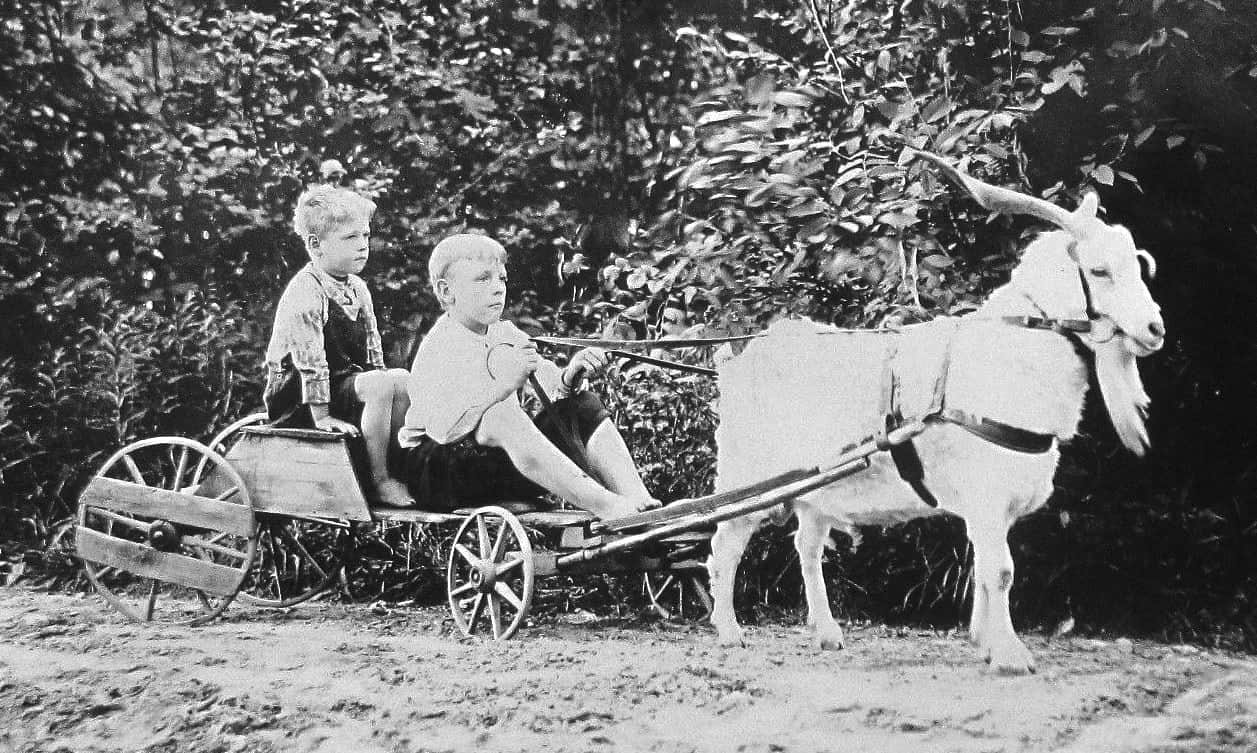
Here’s a fun, real photo postcard.
First you’ll notice a handsome goat hitched to a small wagon with two boys. From a technical standpoint, this is about as good as a photograph can get. The photographer understood how to use sunlight to his advantage. It is extremely sharp with the best tonal qualities. In the hands of a competent photographer these postcards are works of art.
This postcard was never posted and was protected in a postcard album for a hundred years, so it survives in amazing condition. It dates 1910-1920.
The goat
The goat is a stocky critter with a long beard. His long horns have a slight twist. Notice the bit in his mouth. Across the side of his face is a leather strap. Another strap around his neck connects to the harness strap around his girth. The harness is professionally made, unlike the wagon.
The wagon
The wagon is a hoot. It’s a homemade jitney, possibly made by the boys.
Notice the two thin boards, probably from something like an apple crate, that reinforce the rear wheel. This could have been problematic at higher speeds or over rough ground.
Equally important is the floor of the wagon. It too is made of wood and bends slightly under the weight of the two boys. The older brother holds the reins. Both boys are barefoot. The boy in the rear appears to be wearing overalls.
I think some readers in their 50s or older will remember these creative endeavors.
What could go wrong?
If the goat got to running very fast, I think the rear wheel would self-destruct. This would create a problem. Another problem would be if the floor broke under the excess weight. The driver would be laid almost on his back, still drawn by the goat. The younger boy would get the worst of it. The floor in front of the younger boy would hit the ground and dig in, catapulting the younger boy forward. In my family the youngest was expendable.
While I don’t remember the following incident, I remember hearing about it. My older brother Brian and, I think it was, Milan Cook, built something like a soapbox derby car. After a few trial runs they went to the top of High Street to Cassista’s to make a Mario Andretti run. I don’t remember who was driving. At the entrance to our driveway on High Street was a large elm tree. Crash!
I remember building a go-cart when I was 14, using the motor from an old chain saw.
My father worked at J&L. He made a sprocket and welded it to the rear axle. We put a bicycle chain from the rear sprocket to the sprocket on the chain saw. In order to start it, I put a block of wood under the rear axle so the wheels were off the ground.
Then all you had to do was start the chainsaw. Sitting on the go-cart, you would rock the go-cart back and forth until it dropped off the wood block and then you hit the trigger. Zoom, how it would take off, burning gravel!
It didn’t have any brakes and it kept breaking down so I traded it to another kid for an English bike.
Postcard information
In very faint white letters at the bottom left of the postcard is: “Billy, Me, and my Brother.” On the back where the message would have been written is: “Photo made by Porter C. Thayer, Williamsville, Vt.”
Williamsville is not far out of Newfane. While I collect local postcards, some out of the area cards I just can’t refuse, this being one. It takes me back to a time when I was a boy.
Many people don’t realize real photo postcards are exactly that, a photo. Instead of printing the photo on paper like you are familiar with today, they were printed on heavier postcard stock.
Many of these postcards were produced from dry plate glass negatives. Collecting postcards became the rage beginning about 1906 into the 1920s. Everyone collected them.
You could mail friends or family members far away a photo from home, and with a message. It was the emailing of the day.
The Chester Historical Society meeting scheduled for January is canceled. We’ll see where we are in February with the Covid-19. I’ll keep you posted through this column.
This week’s old saying: “It’s better to die on your feet than to live on your knees.”